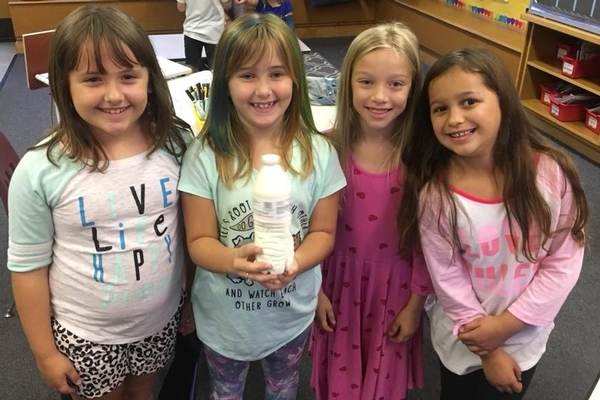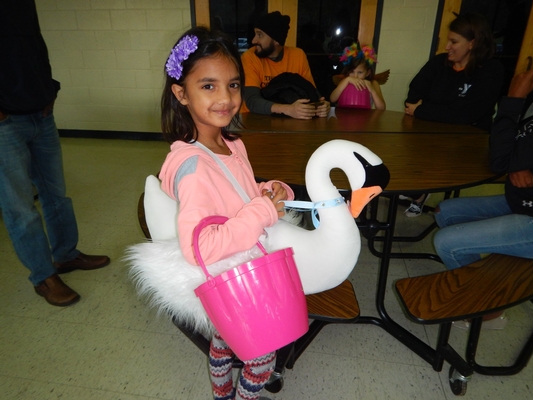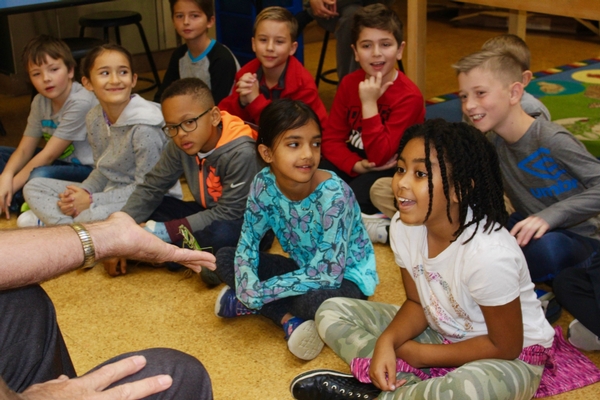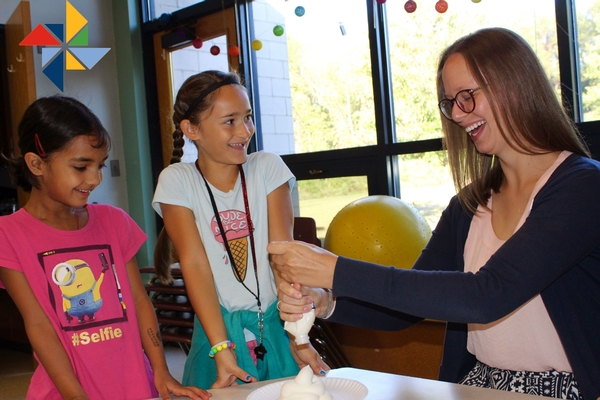Lower School
Lower School Curriculum Overview
The Kindergarten program is collaborative, developmentally appropriate, and built on the tenets of teaching to the whole child. Our classroom provides a caring atmosphere that gives students the freedom to experiment and explore. Through our day we engage them, laugh with them, listen to their stories and allow space for the unique facets of each child to blossom. We believe that the acquisition of knowledge is active and that children learn best when engaged experientially, working in concert with their peers and conducting independent research. Our classroom environment is enriched by playful inquiry and social and emotional support, thus the children in our kindergarten grow to be inquisitive, reflective and critical thinkers. We believe that student driven and teacher guided subject matter comes alive, as our curriculum makes meaning through deep exploration. Classroom investigations are integral to our program and children develop a strong sense of self and community.
Reading and Language Arts
In kindergarten the focus is on a systematic, sequential program for phonics. Teachers preview skills, formally introduce them, then create opportunities for children to apply, integrate, and practice these skills repeatedly as they move toward mastery by the end of the year.
Writing
In writing, the children learn the proper formation of both upper- and lower-case letters. They write in a variety of formats including lists, small moment stories, informational projects and letters.
Math
The math curriculum is centered on the concepts of Everyday Math program. The children learn to write numbers, use manipulatives to help develop an understanding of our number system, create patterns and begin the study of addition and subtraction.
Social Studies
In kindergarten, students learn about themselves and the world around them. They talk about families, how to share and take turns, making friends, and being a helper. Students also get the opportunity to learn about neighborhoods, the world, and how they can take care of it. As part of their study of the world, students learn about a variety of holidays and how they are celebrated.
Science
Students will continue to learn about the process of scientific inquiry in a developmentally appropriate manner and with modeling and support. Topics will come from the three main branches of science - Life, Earth and Space, and Physical, and will support classroom explorations and projects as appropriate. By the end of kindergarten, students will be able to understand and explain that:
*Weather changes are long-term and short-term.
*The moon, sun and stars can be observed at different times of the day or night.
*Objects and materials can be sorted and described by their properties.
*Some objects and materials can be made to vibrate and produce sound.
*Living things have specific characteristics and traits.
*Living things have physical traits and behaviors, which influence their survival.
Technology
Students develop the recognition of technology and the importance of the role it plays in the world. Kindergartners practice and develop persistence, communication, logic, problem-solving, creativity, and collaboration through basic technology skills using the Smart Boards and iPads. Technology class meets once every six days. That class time includes keyboarding practice. Technology topics include basic computer skills, an introduction to internet use and safety, and beginning coding. Keyboarding focuses on maintaining correct posture to avoid aches and pains, using the home row and correct fingering, and accuracy. The curriculum is based on the Ohio Learning Standards and the ISTE (International Society for Technology in Education) Standards.
Spanish
Spanish lessons will cover a variety of themes that will include vocabulary for greetings, numbers, colors, calendar, weather, the body, animals, family, and holidays. Students will be introduced to Spanish language and Hispanic culture through communicative games, songs, rhymes, children’s literature, and physical activity.
Additional Classes
Our students also have Art, Library, Physical Education, Music and Movement. Information about those classes can be found on their respective pages.
Reading and Language Arts
Our goal is for children to become independent, fluent readers who love to read and who read critically and thoughtfully. During first grade, children are introduced to a wide variety of text sets. The students' learning deepens when they think, talk, read, and write about authentic texts across many different instructional contexts. Children work individually, in small groups, and in a whole group setting.
Writing
In first grade students will be creating narratives, opinions, and expository writings using the writing workshop model. Writing workshop is an instructional method that focuses on the strengths and needs of each individual writer. Teachers provide direct instruction on the writing process, craft, genres and mechanics. Students are given time and choice of what to write, and opportunities to share with audiences.
Math
In first grade we use a problem-solving approach based on everyday situations. Students will make connections between their own knowledge and experiences, and learn basic skills in meaningful contexts so that mathematics becomes “real.” Students use a variety of engaging formats for frequent practice of basic skills. In addition to completing daily mixed practice pages, finding patterns on the number grid, and working with addition and subtraction fact families, children will play games designed to develop important skills. To enhance the development of basic skills and concepts, children will revisit previously learned concepts and practice skills encountered throughout the year.
Social Studies
In first grade we discuss the structures of schools and families. Students learn how to get along with classmates, follow school rules, and identify people who work at a school. Students also focus on character development, life skills, and academic learning. We work together to create a classroom geared towards helping each other successfully handle the complexities of contemporary society, reinforcing social skills, critical and creative thinking, ethical decision making, and conflict resolution, and building self-esteem.
Science
Students will continue to learn about the process of scientific inquiry in a developmentally appropriate manner and with modeling and support. Topics will come from the three main branches of science - Life, Earth and Space, and Physical, and will support classroom explorations and projects as appropriate. By the end of first grade, students will be able to understand and explain that:
*The sun is the principal source of energy.
*Water on Earth is present in many forms.
*Properties of objects and materials can change.
*Objects can be moved in a variety of ways, such as straight, zigzag, circular and back and forth.
*Living things have basic needs, which are met by obtaining materials from the physical environment.
*Living things survive only in environments that meet their needs.
Technology
Our students have the opportunity to use multiple types of technology within our classroom. We utilize the SmartBoard multiple times a day. Students watch interactive videos to cement concepts we are focusing on in the classroom. We also incorporate interactive lessons where the students use the board both individually and as a class. We also use iPads in a variety of ways to enhance fundamental first grade skills. Having a class set of iPads gives us endless opportunities for growth in the classroom. Technology class meets once every six days. That class time includes keyboarding practice. Technology topics include basic computer skills, internet safety, beginning coding, an introduction to Google Docs and Slides, and using digital tools to create content. Keyboarding focuses on maintaining correct posture to avoid aches and pains, using the home row and correct fingering, accuracy, and speed. The curriculum is based on the Ohio Learning Standards and the ISTE (International Society for Technology in Education) Standards.
Spanish
Spanish lessons will cover a variety of themes that include vocabulary for greetings, numbers, colors, calendar, weather, the body, animals, family and holidays. Students will be introduced to Spanish language and Hispanic culture through communicative games, songs, rhymes, children’s literature, and physical activity.
Additional Classes
Our students also have Art, Library, Physical Education, Music and Movement. Information about those classes can be found on their respective pages.
Reading and Language Arts
Children become independent, fluent readers who love to read and do so critically and thoughtfully. A balanced reading approach is used with an emphasis on quality literature, poetry, and explicit instruction in phonics (decoding skills). Children work individually, in small groups, and as a whole group. Written and oral comprehension skills such as describing the setting and main characters, finding the main idea, inferring, making predictions, learning new vocabulary, and reaching conclusions are emphasized. Through reading and discussions, children develop critical thinking skills and confidence in their ability to communicate their ideas. Children work with Words Their Way, which is an approach to spelling where children look at words as a whole and identify patterns they see through word study.
Writing
In second grade, children become writers through the use of Lucy Calkins’ Writer’s Workshop. Students go through the following steps in the writing process: pre-writing, drafting, conferencing, proofreading, editing, and publishing. Students experience different types of writing including real life moments, fictional and non- fictional stories, poetry, autobiographies and research reports. The children also learn cursive writing.
Math
Second graders work on skills throughout the year using a hands-on approach where they are encouraged to independently problem-solve. They learn multiple strategies to solve addition and subtraction problems within 20 and how to solve two- and three-digit addition and subtraction problems with and without regrouping. They will learn how to tell time to the minute, count, add and subtract money, tell the temperature, and measure lengths and volume using standard units. They will collect and analyze data, read and write simple fractions, and work with two- and three-dimensional shapes. The children will develop an understanding of place value to 10,000.
Social Studies
Second graders learn about communities. They identify different types of communities, problems communities face, and how to be a good leader and citizen in their own community. They also learn about goods and services and how they are brought to us. Second graders learn about maps and their features. They also spend time researching and writing about the history of the first Thanksgiving.
Science
Students will continue to learn about the process of scientific inquiry in a developmentally appropriate manner and with modeling and support. Topics will come from the three main branches of science - Life, Earth and Space, and Physical, and will support classroom explorations and projects as appropriate. By the end of second grade, students will be able to understand and explain that:
*The atmosphere is primarily made up of air.
*Water is present in the atmosphere.
*Long- and short-term weather changes occur due to changes in energy.
*Forces change the motion of an object.
*Living things cause changes on Earth.
*All organisms alive today result from their ancestors, some of which may be extinct. Not all kinds of organisms that lived in the past are represented by living organisms today.
Technology
Second graders interact with iPads and MacBooks within the classroom. They utilize many online programs to individualize their learning, including RAZ-Kids and Freckle. Technology class meets once every six days. That class time includes keyboarding practice. Technology topics include internet safety, coding, an introduction to Google Docs and Slides, and using digital tools to create content. Keyboarding focuses on maintaining correct posture to avoid aches and pains, using the home row and correct fingering, accuracy, and speed. The curriculum is based on the Ohio Learning Standards and the ISTE (International Society for Technology in Education) Standards.
Spanish
Spanish lessons will cover a variety of themes that will include vocabulary for greetings, numbers, colors, calendar, weather, the body, animals, family and holidays. Students will be introduced to Spanish language and Hispanic culture through communicative games, songs, rhymes, children’s literature, and physical activity.
Additional Classes
Our students also have Art, Library, Physical Education, Music and Movement. Information about those classes can be found on their respective pages.




